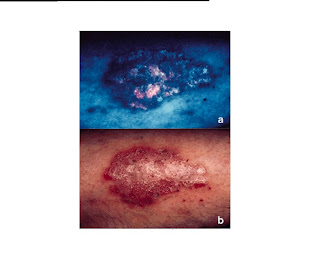Curare [koo rah ree] [1] is a common name for various dart poisons (arrow poisons) originating from South America. The three main types, or families of curare are:
the tubocurare (also known as tube or bamboo curare, because of its packing into hollow bamboo tubes; main toxin is D-tubocurarine). It is a mono-quaternary alkaloid, an isoquinoline derivative.
the calebas curare (also called "gourd curare" by older British classifications, being packed into hollow gourds; main toxins are alloferine and toxiferine)
and the pot curare (packed in terra cotta pots; main toxins are protocurarine, protocurine, and protocuridine).
Curare is an example of a non-depolarizing muscle relaxant (aka, competitive antagonist) which blocks the nicotinic acetylcholine receptor, one of the two types of cholinergic (acetylcholine) receptors, on the post synaptic membrane of the neuromuscular junction. Curare does not occupy the agonist position, but likely binds within the channel pore.
Sunday, January 20, 2008
Saturday, January 19, 2008
Inhalation of spores of which fungus is commonest: aspergillus
Only pathogenic yeast in man: C. neoformans
Asteroid bodies are a characteristic feature of: sporothrix
Sporulation occurs in which phase: phase of decline
Characteristic feature of coccidiomycosis: spherule formation
Copper pennies appearance in tissue: paracoccidiodes
Most characteristic clinical feature of all cases of paracoccidiodomycosis: lymph node enlargement
Fungus which is urease positive: C. neoformans
Only pathogenic yeast in man: C. neoformans
Asteroid bodies are a characteristic feature of: sporothrix
Sporulation occurs in which phase: phase of decline
Characteristic feature of coccidiomycosis: spherule formation
Copper pennies appearance in tissue: paracoccidiodes
Most characteristic clinical feature of all cases of paracoccidiodomycosis: lymph node enlargement
Fungus which is urease positive: C. neoformans
capgrass syndromeIn the Capgras syndrome the patient is deluded that a person closely related to him has been replaced by an identical double.
In the Capgras syndrome the patient is deluded(misslead) that a person closely related to him has been replaced by an identical double.
This is an extremely rare condition and is usually associated with schizophrenia or affective disorder.
Occasional cases of Capgras syndrome are seen following brain injury (usually in the temporal area) or cerebral atrophy.
This condition may be rarely associated with a pituitary tumour.
This is an extremely rare condition and is usually associated with schizophrenia or affective disorder.
Occasional cases of Capgras syndrome are seen following brain injury (usually in the temporal area) or cerebral atrophy.
This condition may be rarely associated with a pituitary tumour.
Friday, January 18, 2008
nikoliskey sign

Nikolsky's sign involves the superficial layers of skin slipping free from the lower layers with slight pressure.
Reference from A.D.A.M.
Back to TopConsiderations
A positive Nikolsky's sign is present in the scalded skin syndrome (caused by staphylococcal infection) and in a slightly different form in toxic epidermal necrolysis (a severe drug reaction). It may also be seen in pemphigus vulgaris (a disease which causes blisters to form on the skin).
In each of these diseases, the skin is loosened and when rubbed, slips free just as the skin on a blanched tomato or peach would. The area beneath is pink and moist and may be very tender.
Back to TopCommon Causes
Scalded skin syndrome (also called Ritter disease)
Toxic epidermal necrolysis
Pemphigus vulgaris
Reference from A.D.A.M.
Back to TopConsiderations
A positive Nikolsky's sign is present in the scalded skin syndrome (caused by staphylococcal infection) and in a slightly different form in toxic epidermal necrolysis (a severe drug reaction). It may also be seen in pemphigus vulgaris (a disease which causes blisters to form on the skin).
In each of these diseases, the skin is loosened and when rubbed, slips free just as the skin on a blanched tomato or peach would. The area beneath is pink and moist and may be very tender.
Back to TopCommon Causes
Scalded skin syndrome (also called Ritter disease)
Toxic epidermal necrolysis
Pemphigus vulgaris
Wood's lamp excamination
Thursday, January 17, 2008
Wood's lamp lesion
Wednesday, January 16, 2008
Subscribe to:
Comments (Atom)










